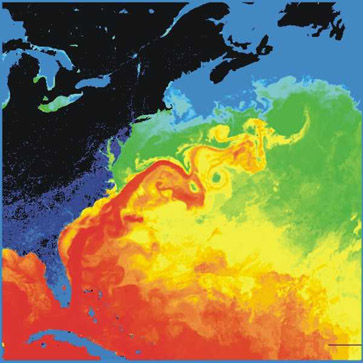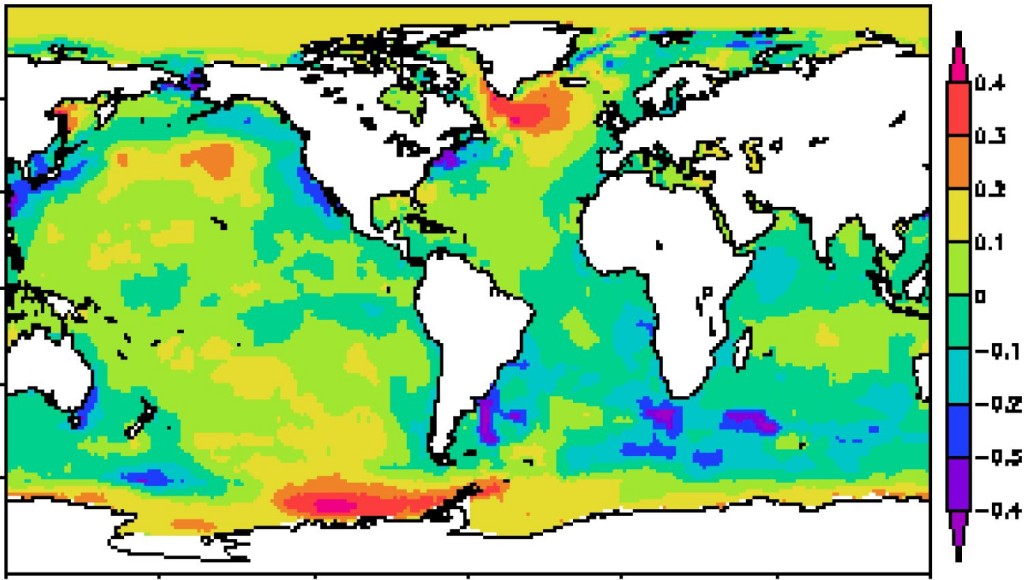Recent weather events in the north eastern US have brought some interesting research to the forefront. The result is that the Gulf Stream may be stopping and that has huge implications for weather in the US and Europe.
What is the Gulf Stream?
The Gulf Stream is a very powerful ocean current that “originates” (for some value of originate) in the Gulf of Mexico, with it’s warm shallow waters and flows up the East coast of the US. It is about 100 kilometers wide and goes from about 800 meters to 1200 meters in depth. It’s fast, about 2.5 meters per second (5.6 miles per hour). That doesn’t sound like much, but it is very fast.
The current moves 30 sverdrups (no I’m not making that up) through the Florida straights, which is about 30 million cubic meters of water per second. Up near Newfoundland, the rate is closer to 150 sverdrups (150 million cubic meters of water per second). You can see the warm gulf waters in the thermal image below.

After the bit you see here, the Gulf Stream continues over to hit Europe. The Stream splits with part going north of the British isles and part going south, past Spain and northern Africa. This bit then heads back across the Atlantic and into the Gulf of Mexico.
The Gulf Stream causes quite a few, otherwise weird, local climate effects. Florida, of course, is quite warm all year round, not only because of it’s southern location, but because of the Gulf Stream. This extends up all the way to Nantucket, Massachusetts, which is the northern most extent of southern organisms, being warmer than average year round.
Ireland and the west coast of Britain are a few degrees warmer than the east. Most of the coastline of Norway is ice free, year-round, due to the remaining heat of the Gulf Stream.
Of course, I couldn’t help but mention that the warm waters of the Gulf Stream give rise to hurricanes, effectively year-round.
What is the new research?
Early in 2016, the waters off the coast of New England were 5-6 degrees (F) warmer than average. This provided tremendous amounts of energy to the blizzard. Yes, this type of storm is strengthened by very localized temperature and moisture differences. Relatively warm, but moisture heavy air is coming up from the Virginia coast and hitting the cold, dry Canadian air. This air, rapidly cooled, resulting in epic snowfall throughout the region.
So, why are the sea surface temperatures so much warmer?
At least one hypothesis is that this is the result of the slowing of the Gulf Stream. The waters off the US east coast are warming faster than global average temperatures. Related, there is a mass of cold water off of Greenland.

Now, what’s really interesting about this is that this can be reproduced by highly detailed climate models. I need to add that the colors are reversed in this image. Warmer is bluer and cooler is redder. There are technical reasons.
A more recent model (Saba 2015) shows this effect by only doubling the CO2 content of the atmosphere. In other words, this is evidence supporting the idea that global warming, caused by man, is resulting a massive change in ocean and weather patterns.
The cold section of water seems to be drainage from Greenland. The water there had record breaking cold temperatures, in spite of record breaking heat over the rest of the globe.
What is the result of a Gulf Stream slowdown (or stop)?
This has been the subject of much research over the last several years (Levermann 2005, Woolings 2012, and Yin 2009, for examples).
The events discussed in these papers include the increase in frequency and strength of North Atlantic storms impacting Europe and dramatically higher than expected sea level rise along the US east coast. Another paper goes into a little more detail.
These include: widespread cooling throughout the North Atlantic and northern hemisphere in general; less precipitation in the northern hemisphere midlatitudes; large changes in precipitation in the tropics and a strengthening of the North Atlantic storm track. The focus on Europe, aided by the increase in resolution, has revealed previously undiscussed impacts, particularly those associated with changing atmospheric circulation patterns. Summer precipitation decreases (increases) in northern (southern) Europe and is associated with a negative summer North Atlantic Oscillation signal. Winter precipitation is also affected by the changing atmospheric circulation, with localised increases in precipitation associated with more winter storms and a strengthened winter storm track. Stronger westerly winds in winter increase the warming maritime effect while weaker westerlies in summer decrease the cooling maritime effect. In the absence of these circulation changes the cooling over Europe’s landmass would be even larger in both seasons. The general cooling and atmospheric circulation changes result in weaker peak river flows and vegetation productivity, which may raise issues of water availability and crop production.
So there we are. There is now some pretty compelling evidence that we are directly altering some of the most powerfuls systems on the planet. And, to be honest, that’s probably not going to end well for us.
The Gulf Stream has a well understood point at which it will collapse (Lenton 2008). Basically a large input of freshwater (say, from Greenland ice sheet melting) could cause the Gulf Stream to collapse. In some models, it restarts if the freshwater goes away. In some it does not.
The final estimate is that a collapse of the Gulf Stream is well possible this century.
___________________________________________________
M. Dima, and G. Lohmann, “Evidence for Two Distinct Modes of Large-Scale Ocean Circulation Changes over the Last Century”, Journal of Climate, vol. 23, pp. 5-16, 2010.http://dx.doi.org/10.1175/2009JCLI2867.1
T.M. Lenton, H. Held, E. Kriegler, J.W. Hall, W. Lucht, S. Rahmstorf, and H.J. Schellnhuber, “Tipping elements in the Earth’s climate system”, Proceedings of the National Academy of Sciences, vol. 105, pp. 1786-1793, 2008. http://dx.doi.org/10.1073/pnas.0705414105
A. Levermann, A. Griesel, M. Hofmann, M. Montoya, and S. Rahmstorf, “Dynamic sea level changes following changes in the thermohaline circulation”, Clim Dyn, vol. 24, pp. 347-354, 2005. http://dx.doi.org/10.1007/s00382-004-0505-y
V.S. Saba, S.M. Griffies, W.G. Anderson, M. Winton, M.A. Alexander, T.L. Delworth, J.A. Hare, M.J. Harrison, A. Rosati, G.A. Vecchi, and R. Zhang, “Enhanced warming of the northwest Atlantic Ocean under climate change”, J. Geophys. Res. Oceans, pp. n/a-n/a, 2015. http://dx.doi.org/10.1002/2015JC011346
T. Woollings, J.M. Gregory, J.G. Pinto, M. Reyers, and D.J. Brayshaw, “Response of the North Atlantic storm track to climate change shaped by ocean–atmosphere coupling”, Nature Geosci, vol. 5, pp. 313-317, 2012. http://dx.doi.org/10.1038/NGEO1438
J. Yin, M.E. Schlesinger, and R.J. Stouffer, “Model projections of rapid sea-level rise on the northeast coast of the United States”, Nature Geosci, vol. 2, pp. 262-266, 2009. http://dx.doi.org/10.1038/ngeo462
